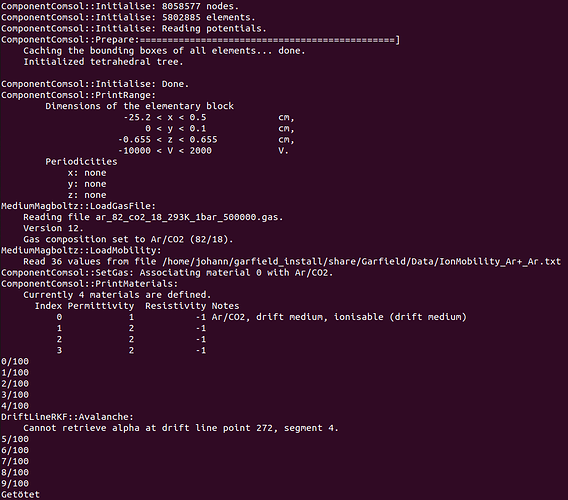Hi,
I’m simulating a Drift Chamber and use Comsol as a field solver and adapted the Comsol example. 100 muons passing through the chamber at different distances from the anode wire and I want to collect all the data from drift.GetEndPoint(xf, yf, zf, tf, status) and save it in a file. I have run it before with distance spacings of 1 cm and it worked fine. Now I tried to rerun the code with a spacing of 1 mm and the program keeps taking too long and gets killed. I use a gas file that covers energies from 100 V/cm to 500000 V/cm in 20 steps with a logarithmic spacing because I have electric potentials of -10000 V to 2000 V. I have tried different gas, mesh and potential files to see if it is maybe too much to load into garfield but nothing changed. This is my code:
#include <cstdlib>
#include <iostream>
#include <fstream>
#include <sys/stat.h>
#include <sys/types.h>
#include <TApplication.h>
#include <TCanvas.h>
#include <TH1F.h>
#include "Garfield/ComponentComsol.hh"
#include "Garfield/ViewField.hh"
#include "Garfield/ViewFEMesh.hh"
#include "Garfield/MediumMagboltz.hh"
#include "Garfield/Sensor.hh"
#include "Garfield/AvalancheMicroscopic.hh"
#include "Garfield/AvalancheMC.hh"
#include "Garfield/Random.hh"
#include "Garfield/DriftLineRKF.hh"
#include "Garfield/TrackHeed.hh"
using namespace Garfield;
int main(int argc, char * argv[]) {
TApplication app("app", &argc, argv);
// Load the field map.
ComponentComsol fm;
fm.Initialise("mesh.mphtxt", "dielectrics.dat", "field.txt", "mm");
fm.PrintRange();
// Setup the gas.
MediumMagboltz gas;
gas.LoadGasFile("ar_82_co2_18_293K_1bar_500000.gas");
// Load the ion mobilities.
const std::string path = std::getenv("GARFIELD_INSTALL");
gas.LoadIonMobility(path + "/share/Garfield/Data/IonMobility_Ar+_Ar.txt");
// Associate the gas with the corresponding field map material.
fm.SetGas(&gas);
fm.PrintMaterials();
// Create the sensor.
Sensor sensor;
sensor.AddComponent(&fm);
//sensor.SetArea(-25.2, 0, -0.5, 0, 0.1, 0.5);
// Set up Heed.
TrackHeed track;
track.SetParticle("muon");
track.SetEnergy(3.e9);
track.SetSensor(&sensor);
// RKF integration.
DriftLineRKF drift(&sensor);
//drift.SetGainFluctuationsPolya(0., 20000.);
// Create a new directory
const std::string outputDir = "electron_positions_mu_3GeV_293K_1mm_test/";
mkdir(outputDir.c_str(), 0777);
for (double x0 = -0.1; x0 >= -25.2; x0 -= 0.1) {
std::ofstream outFile(outputDir + "electron_positions_" + std::to_string(x0) + ".txt");
if (!outFile) {
std::cerr << "Fehler beim Erstellen der Datei!" << std::endl;
return 1;
}
// Write the header
outFile << "x y z E t x_e y_e z_e t_e\n";
constexpr unsigned int nEvents = 100;
for (unsigned int i = 0; i < nEvents; ++i) {
std::cout << i << "/" << nEvents << "\n";
sensor.ClearSignal();
track.NewTrack(x0, 0.05, 0.496, 0, 0, 0, -1);
for (const auto& cluster : track.GetClusters()) {
for (const auto& electron : cluster.electrons) {
double xe = electron.x;
double ye = electron.y;
double ze = electron.z;
double ee = electron.e;
double te = electron.t;
drift.DriftElectron(electron.x, electron.y, electron.z, electron.t);
double xf = 0., yf = 0., zf = 0., tf = 0.;
int status = 0;
drift.GetEndPoint(xf, yf, zf, tf, status);
// Write the data to the file
outFile << xe << " " << ye << " " << ze << " " << ee << " " << te << " " << xf << " " << yf << " " << zf << " " << tf << "\n";
}
}
}
outFile.close();
}
app.Run(kTRUE);
}
And this is the terminal output:
Do you have any idea what could be the reason for the program to get stopped after a specific time? I would appreciate your help, thanks!



